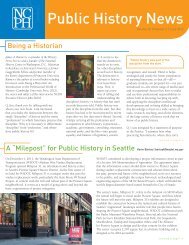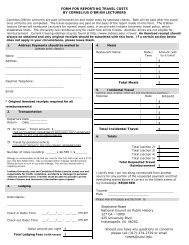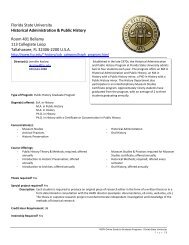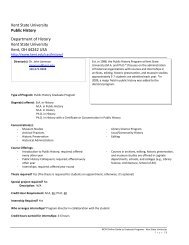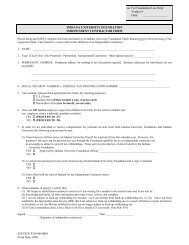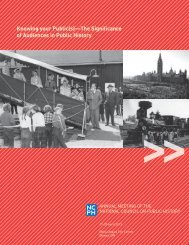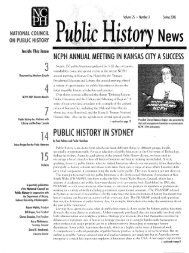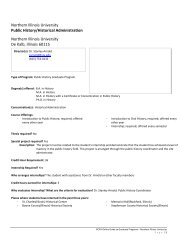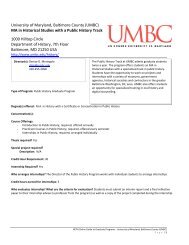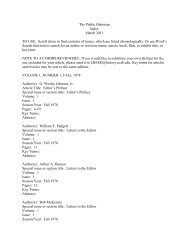Case Statement - National Council on Public History
Case Statement - National Council on Public History
Case Statement - National Council on Public History
Create successful ePaper yourself
Turn your PDF publications into a flip-book with our unique Google optimized e-Paper software.
to write for different mediums bey<strong>on</strong>d the traditi<strong>on</strong>al research paper; to think about the<br />
c<strong>on</strong>necti<strong>on</strong>s between design, imagery, and message; to think about how social media and web<br />
2.0 technologies can be used in educati<strong>on</strong>al and cultural c<strong>on</strong>texts; appropriately adopt new<br />
technologies.<br />
Early in the semester we have some traditi<strong>on</strong>al lectures and readings <strong>on</strong> archives and<br />
digital history, but as the semester progresses the students take <strong>on</strong> increasing resp<strong>on</strong>sibility for<br />
projects and presentati<strong>on</strong>s. Some students really enjoy the challenge and freedom of pursuing<br />
their own projects and working with me and the university archivist <strong>on</strong> projects that will<br />
become part of the university’s web page.<br />
The first theme is that the students need to explore and adapt the appropriate digital<br />
tools. Students are familiar with a wide variety software, but have not given thought to how<br />
they might be applied to history combined with a general lack of awareness of tools specifically<br />
designed for history (or related areas). Sometimes this is a questi<strong>on</strong> of jarg<strong>on</strong>. For example, in<br />
<strong>on</strong>e class we were talking about “web 2.0” <strong>on</strong>ly to find that many of students didn’t know what<br />
that meant. They used web 2.0 technologies but did not know they were called “web 2.0.” We<br />
emphasize that the software will change so the important task is to think about how to apply<br />
the tool realizing that change is inevitable. We also help the students use tools like Zotero to<br />
do research rather than relying <strong>on</strong> pen and paper.<br />
A sec<strong>on</strong>d theme is the use of archival materials to create a “live” digital history project.<br />
If their work is good enough, it will be used by the archives and be available to the public.<br />
Students are forced to work collaboratively and publically with an emphasis <strong>on</strong> problem solving.<br />
<strong>History</strong> 419 is team-taught by the university archivist providing a focus and grounding in work<br />
familiar to history majors. Students pick from a list of archival collecti<strong>on</strong>s and digital projects.<br />
In some instances students have collaborated by doing part of <strong>on</strong>e large project and in other<br />
instances their projects are not c<strong>on</strong>nected. For example, a few years ago an alum who had<br />
recently retired from C<strong>on</strong>gress d<strong>on</strong>ated his papers. Students were resp<strong>on</strong>sible for organizing a<br />
porti<strong>on</strong> of the collecti<strong>on</strong> and building a web page and data base that c<strong>on</strong>tributed to a whole.<br />
Obviously, we d<strong>on</strong>’t have this opportunity every time we teach the class.<br />
The primary challenge for teaching the digital history course is to (1) find good student<br />
projects, (2) c<strong>on</strong>vince history majors that this really is something they should do (3) stay abreast<br />
of changing technologies and find the resources to bring it to the classroom.



